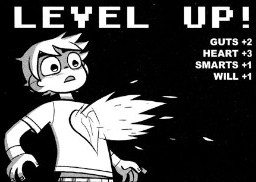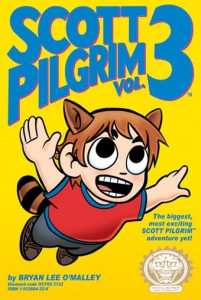Summer Media: The Scott Pilgrim Comics Series
Bryan Lee O’Mal ley’s indie comedy/action/romance series Scott Pilgrim has cultivated a rabid fanbase quick to shove the first book into the hands of any non-comics reader expressing even the vaguest interest in the medium. As they should. Because it’s glorious. Get in on the action before Universal’s film adaptation arrives this month.
ley’s indie comedy/action/romance series Scott Pilgrim has cultivated a rabid fanbase quick to shove the first book into the hands of any non-comics reader expressing even the vaguest interest in the medium. As they should. Because it’s glorious. Get in on the action before Universal’s film adaptation arrives this month.
Scott Pilgrim’s storyworld operates akin to a sort of 8-bit videogame magical realism in which a heartfelt “I love you” gives the protagonist enough experience points to gain the “power of love” achievement bonus . . . and a flaming sword to wield against his enemies. The series, told across six digest-sized graphic novels (starting with Scott Pilgrim’s Precious Little Life in 2004 and culminating in last month’s Scott Pilgrim’s Finest Moment), propels itself forward with a bombastic Ritalin-and-Pixy-Stix mania perfectly at ease with inhabiting the space between Street Fighter and Gilmore Girls. It follows twenty-three year-old slacker hero Scott Pilgrim’s effort to find love, employment, a venue willing to book his band Sex-Bob-Omb more than once, and generally get his act together. The impetus for change comes when Scott meets and (so very awkwardly) woos oversized mallet-wielding street samurai and Amazon.ca delivery girl Ramona V. Flowers. Before he can win her heart, however, Scott must first defeat her seven evil exes in physical combat, which isn’t as unlikely as it seems in a world where your prowess playing beat-‘em-up video games directly translates to your fighting skills in real life, and in which your opponents, once vanquished, burst into a shower of coins familiar to anyone who’s ever played Nintendo games in the 1980s.
O’Malley chooses a deceptively simple style for the series, combining expressive manga-tinged character work with a visual representation of Toronto faithful enough to inspire at least one “Scott Pilgrimage.” His ability to convey the series’ cartoonish action is impressive, but O’Malley’s capacity to capture his cast’s emotional motivations and reactions—subtle and outrageous—is key as they negotiate an ever-increasing spiderweb of interpersonal relations threading in and out of multiple timelines. Dozens of characters populate O’Malley’s work, both as part of the Toronto scene’s larger social circle and several subcliques (every primary character has his or her own group of friends and rivals), all realized with their own backstories, impulses, and quirks, united only in their penchant towards highly quotable buffyspeak. Indeed, perhaps the most treasured page of the series is the map at the end of the third book (the halfway point) that traces out the top dozen characters’ relationships with each other. It, for instance, reminds us that minor player Julie Powers is on-and-off dating Sex-Bob-Omb frontman Steven Stills, loathes band hanger-oner Young Neil, and wants to re-friend college roommate (and Scott’s ex) Envy Adams now that she’s famous.
Scott Pilgrim’s status within the canon of comics is assured. Excitement over the movie and the final volume is at a fever pitch. The former, buoyed by a pair of Apple.com-crashing trailers, a series of seven video remixes featuring original music and previously unreleased footage as part of a massive internet marketing campaign, and above all else, director Edgar Wright’s reported obsessive adherence to the source material, has driven fans to extremes of anticipation so great that Wright himself has attempted to temper their excitement. The series currently occupies the six top spots on the New York Times’ Paperback Graphic Novels list, and the final volume ranked #5 overall in Books (topping the Julia Roberts film cover edition of Eat, Pray, Love) and #1 in Comics and Graphic Novels at Amazon on the day of its release. All that said, Scott Pilgrim might very well end up being more of an orphan than progenitor—despite it’s success, few, if any, creators have attempted to replicate its success in either style or content in the half-decade since Oni released the first volume.
To put it simply, there’s absolutely nothing out there like it. Those interested can find a lengthy preview of the first book here.




So happy to read a post on Antenna about these fantastic comics — past even Inception, the Scott Pilgrim movie has been my most anticipated film this summer.
One thing you point out is how deftly O’Malley is able to take the visual language of games and incorporate it into comic form, probably the most famous being when Scott, drunk at a bar, needs to go to the bathroom and the panel progression indicating his “urine bar” decreasing as he relieves himself. It’s irreverant, hilarious, well-plotted, and just plain fun.
But, since O’Malley’s taken an an interactive, multimodal medium like the videogame and then reduced it to the purely visual juxtaposition of panels in a comic, I’m curious to see how Edgar Wright takes these same gags and expands them back into audio-visual gags. What kinds of gaming sound effects will Wright rely on — sounds largely drawn from real games, or some kind of abstracted game sounds? What about the gaming iconography?
There is at least one hint to this with Wright announcing that the The Legend of Zelda theme will appear in the movie, and had to be approved by Shigeru Miyamoto himself. I’m curious to see in what ways Wright ties his adaptation of O’Malley’s book to existing gaming franchises, and how that changes the feel of experience.
Can’t wait for this, and I’d suggest this post get tagged “Games” as well — so much of O’Malley’s work is about moving games into the comics world, and it seems to be a concern for Wright as well. Great post!!!
Scott Pilgrim is truly a quintessential manifestation of this generation.
Everything about the comic series is perfect representation of a new idyllic lifestyle – a world where you’re with your friends all the time, where everyone’s a slacker but it all works out, and where every accomplishment is greeted with a tangible reward.
If the movie is half as good as the graphic novels, it will still be the best offbeat release since “Shaun of the Dead” (not coincidentally also an Edgar Wright directorial). The casting is literally perfect, though I would question Cera as the upbeat optimist Scott Pilgrim if he wasn’t so established in the “nerdy cool” typecast.
The reviews have been generally incredulous – a fine example being from Ain’t It Cool: http://www.aintitcool.com/node/46023
Cheers!